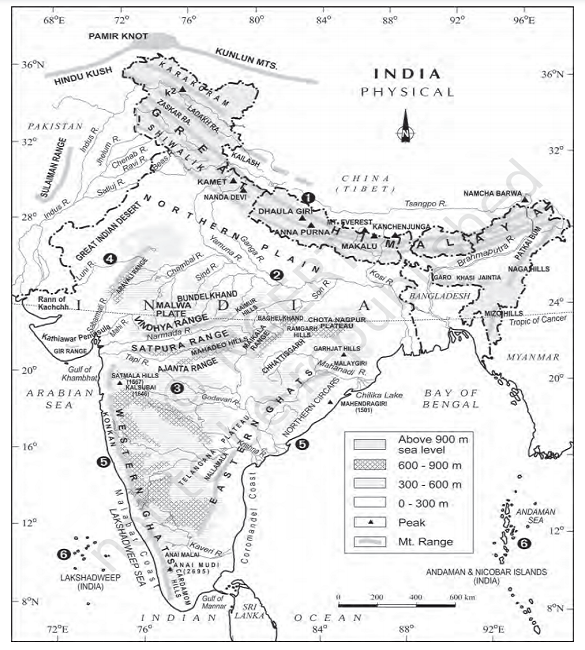Table of Contents
Physiography of India- Himalayas
Geological Divisions:
A geological period is one of the several sub-divisions of geologic time enabling cross-referencing of rocks and geologic events from place to place.
These periods form elements of a hierarchy of divisions into which geologists have split the earth’s history.
The variations in the geological structure and formations leads to geological divisions.
India can be divided into three geological divisions due to interplay of these endogenic and exogenic forces and side wise movement of the plates. These are-
The Peninsular Block:
- The Peninsula is formed essentially by a great complex of very ancient gneisses and granites.
- The northern boundary of the Peninsular block may be taken as an irregular line running from kachchh along the western flank of the Aravali Range near Delhi.
- Karbi Anglong and the Meghalaya plateau in the northeast and Rajasthan in the west are also extensions of this block.
- The northeastern parts are separated by the Malda Fault in the West Bengal from the Chotanagpur plateau.
- The Peninsula mostly consists of relict and residual mountains like Aravali hills, the Nallamala hills, the Javadi hills, the Veliconda hills, the Palkonda range, and the Mahendragiri hills, etc.
- The rift valleys of the Narmada, the Tapi and the Mahanadi and the Satpura block mountains are examples of the vertical movements and block faulting due to tectonic activity in the Peninsula.
The Himalayas Mountains:
- The Himalayas are young, weak, and flexible in their geological structure.
- The Himalayas are not only the physical barrier, but they are also a climatic, drainage, and cultural divide.
- The mountains are supposed to emerge out of ‘The Tethys Sea‘.
- These mountains are tectonic in origin dissected by fast-flowing rivers.
- Various landforms like gorges, V-shaped valleys, rapid, waterfalls, etc. are indicative of this stage.
- The altitudinal variations are greater in the eastern half than those in the western half.
- The Himalayas as Young Mountains:
- Presence of fossils in Shiwalik similar to Tibetan plateau.
- The frequent occurrence of Earthquakes similar to the Tibetan plateau.
- Himalayan rivers are still in their youthful age with characteristic V-gorges, steep waterfalls.
Indo-Ganga- Brahmaputra Plain:
- It comprises the plains formed by the river Indus, the Ganga and the Brahmaputra.
- It was a geo-synclinal depression that attained its maximum development during the third phases of the Himalayan mountain formation approximately about 64 million years ago.
- The average depth of alluvial deposits in these plains ranges from 1000-2000 meters.
- The relief and physiography of India have been greatly influenced by the geological and geomorphological processes active in the Indian subcontinent.
Physiographic Division:
Physiography of an area is the outcome of structure, process and the stage of development.
The land of India is characterised by great diversity in its physical features like-
- The north has a vast expanse of rugged topography consisting of a series of mountains ranges with varied peaks, beautiful valleys and deep gorges.
- The south consists of a stable table land with highly dissected plateaus, denuded rocks and developed series of straps.

Based on these variations, India can be divided into the following physiographic divisions-
- The Northern and North-eastern Mountains.
- The Northern Plains.
- The Peninsular Plateau.
- The Indian Desert.
- The Coastal Plains.
- The Islands.
The Northern and North-eastern Mountains:
- It consists of the Himalayas and the North-eastern hills.
- The Himalayas consist of a series of a parallel mountain range like the Great Himalayan range which includes the Great Himalayas and the Shiwalik.
- These ranges are from northwest to southeast direction in the northwestern part of India.
- The Himalayas in the Darjiling and Sikkim regions lie in an eastward direction while Arunachal Pradesh, they are from southwest direction to the northwest direction.
- Nagaland, Manipur, and Mizoram are in the north-south direction.
- The approximate length of the Great Himalayan range also known as the central axial range is 2500 km from east to west and their width varies between 160-400 km from north to south.
Broad ranges of Himalayas:
Northern Most Range:
- It is also known as the Great or Inner Himalayas or the ‘Himadri’.
- It consists of the loftiest peaks with an average height of 6000m.
- The Great Himalayas are asymmetrical in nature.
- The core of some parts of the Himalayas is composed of highly compressed and altered rocks.
- Its southern slope is steep and the northern slope is gentle.
- The altitude varies between 3700 and 4500m and the average width is 50 km.
- Some of the world’s highest peaks located here. Mount Everest is located in Nepal. Kanchenjunga is the highest mountain in India. Nanda Devi, Dhaulagiri, Nanga Parbat, etc. also located here.
Mid Himalayas or Lesser Himalayas or Himachal:
- The lesser Himalayas are composed of ancient sedimentary and metamorphic rocks.
- Valley of Kashmir lies in these.
- These are less hostile and most of the hill resorts like Kullu, Manali, Shimla, Nainital, etc are located here.
Shiwalik or the Lower Himalayas:
- It is the southernmost range and is least in Average height.
- Also called Outermost Himalayas.
- They were almost continuous and blocked the courses of rivers which in the past led to the formation of lakes which after drying led to the formation of plains called Duns in the West and called Duars in the east.
On the basis of relief, alignment of ranges, and other geomorphological features, the Himalayas can be divided into the following sub-divisions:
- Kashmir or North-western Himalayas.
- Himachal and Uttaranchal Himalayas.
- Darjiling and Sikkim Himalayas.
- Arunachal Himalayas.
- Eastern Hills and mountains.
Kashmir or North-western Himalayas:
- It comprise a series of ranges such as the Karakoram, Ladakh, Zaskar and Pir Panjal.
- The northeastern part of the Kashmir Himalayas is a Cold Desert which lies between Greater Himalayas and Karakoram ranges.
- The famous valley of Kashmir and Dal Lake lies between the Great Himalayas and Pir Panjal range.
- Important glaciers of South Asia such as the Baltoro and Siachen are found in this region.
- The Kashmir Himalayas are famous for Karewa formation (thick deposits of glacial clay and other materials embedded with moraines) useful for the cultivation of Zafron, a local variety of Saffron.
- Some of the important passes of the region are-
- Zojila– Great Himalayas.
- Banihal– Pir Panjal.
- Photo La– Zaskar.
- Khardung La– Ladhak range.
- Lakes such as Dal and Wular and Salt Water lakes such as Pangong Tso and Tso Moriri are also in this region.
- Vaishno Devi, Amarnath Cave, Charar-e-Sharif, etc. are also located here.
- Srinagar is located on the banks of the Jhelum river.
- In Kashmir valley, the meanders in the Jhelum river are caused by the local base level provided by the erstwhile larger lake.
- The Southernmost part of this region consists of longitudinal valleys known as ‘duns‘. Example- Jammu dun and Pathankot dun.
The Himachal and Uttarakhand Himalayas:
- This part lies between the Ravi in the West and Kali (a tributary of Ghaghara in the east).
- It is drained by two major river systems- Indus and Ganga.
- Tributaries of Indus– Ravi, Beas, Satluj.
- Tributaries of Ganga– Yamuna, Ghaghara.
- The northernmost part of the Himachal Himalayas is an extension of the Ladakh cold desert, which lies in the Spiti subdivision of district Spiti and Lahul.
- The Lesser Himalayas is known as Dhaoladhar in Himachal Pradesh and Nagtibha in Uttarakhand.
- In lesser Himalayas, the altitude is between 1000-2000m.
- Important hill stations like Dharamshala, Mussoorie, Shimla, Kaosani, and health resorts like Almora, Kasauli, Ranikhet, etc. developed in this region.
- The two distinguishing features from the point of view of physiography are the Shiwalik and Dun Formations.
- Important Duns located in this region are the Chandigarh Kalka dun, Nalagarh dun, Dehra Dun, Harike Dun, and the Kota Dun, etc.
- Dehra Dun is the largest of all the duns with an approximate length of 35-45 km and a width of 22-25 km.
- The valleys of the Great Himalayas range are inhabited by the Bhotia’s (the nomadic groups) who migrate to ‘Bugyals‘.
- Valley of Flowers (Uttarakhand) also located in this region.
- Gangotri, Yamunotri, Kedarnath, Badrinath, and Hemkund Sahib are important pilgrimage places.
The Darjiling and Sikkim Himalayas:
- They are flanked by Nepal Himalayas in the West and Bhutan Himalayas in the East.
- It is known for its fast-flowing rivers such as Tista.
- It is a region of high mountain peaks like Kanchenjunga and deep valleys.
- The reaches of this region are inhabited by Lepcha tribes.
- They are known for their scenic beauty and rich flora and fauna, particularly various types of orchids.
Arunachal Himalayas:
- These extend from the east of the Bhutan Himalayas up to the Diphu pass in the east.
- Important peaks are Namcha Barwa and Kangtu.
- Important rivers are Kameng, Subansari, Dihang, Dibang, Lohit.
- Tribal communities inhabiting these areas are Monpa, Daffla, Abor, Mishmi, Nishi, and Nagas.
- These communities practicing Jhumming also know as Slash and Burn Cultivation.
The Eastern Hills and Mountains or the Purvanchal:
- These are part of the Himalayan mountain and are known by different local names like in the north, they are known as Patkai Bum, Naga hills, which form the boundary between India and Myanmar, and in the south as Mizo or Lushai hills. Towards the west is Kohima hills.
- Barak, an important river in Manipur and Mizoram. It is the tributary of Meghna.
- The physiography of Manipur is unique by the presence of a large lake known as Loktak Lake.
- Mizoram is also known as the Molasses basin.
- The rivers in the eastern part of Manipur are the tributaries of Chindwin.
- Chindwin is a tributary of the Irrawady of Myanmar.
Significance of the Himalayas:
- The mighty range of the Himalayas exercising great influence over the climatic condition, economy, and society of the Indian subcontinent.
- They provide a natural protective wall from the extremely cold winds of Siberia and also stop the southern monsoon winds from crossing over.
- Many important rivers originate from the Himalayan glaciers and flow into the plains. These rivers are the source of livelihood for the millions of people who are dependent on their water for irrigation.
- Many rivers descending from the Himalayas carry enormous quantities of alluvium. These rivers deposit the alluvium in the great plain of North India making this plain one of the most fertile plains in the world.
- The uneven terrain of the Himalayas causes the river to form numerous rapids and waterfalls which can be used for generating hydroelectricity. Important hydroelectricity projects are Bhakra Nangal, Tehri, Kosi, and Pong dams.
- The forests on the slopes provide valuable timber such as sal, deodar, pine, and other forest-based products such as resin, oil, and various medicinal herbs.
- The Himalayas have important deposits of metallic and non-metallic minerals such as limestone, magnesite, phosphorite, silica, tungsten, copper, gypsum, etc.
- A large number of tourist places have developed in the Himalayan ranges due to scenic beauty in the form of snow-clad mountains, lush forests, sparkling lakes, and wildlife which are a great source of attraction for the people.
The Northern Plains:
- These plains are formed by the alluvial deposits brought by the rivers- Indus, Ganga and the Brahmaputra.
- These plains extend approximately 3200 km from the east to the west.
- The average width is 150-300 km.
- The Brahmaputra plains are known for their riverine islands and sand bars.
- The states of Delhi and Harayana form a water divide between the Indus and Ganga river system.
- The Brahmaputra river flows from the northeast to the southwest direction.
- It takes almost 90° southward turn at Dhubri before it enters into Bangladesh.
- These plains are divided into three major zones- the Bhabar, the Tarai, and alluvial plains.
Bhabar:
- It is a narrow belt ranging between 8-10 km parallel to the Shiwalik foothills at the break-up of the slope.
- As a result of this, the streams and rivers coming from the mountains deposit heavy materials of rocks and boulders, and at times, disappear in this zone.
- It forms the Northern boundary of alluvial plains. As the region is made of assorted sediments like pebbles which have high porosity and hence river streams sink in this region. That’s why, except for the rainy season, this area is dry.
- The area is not suitable for agriculture and only big deep-rooted trees thrive here.
Tarai:
- South of bhabar belt, the streams and rivers re-emerge and create a wet, swampy and marshy region known as terai.
- This was a thickly forested region full of wildlife.
- The region is wetter towards the east for higher rainfall in the region.
- The forests have been cleared to create agricultural land and to settle migrants from Pakistan after partition.
- This has a luxurious growth of natural vegetation and houses varied wildlife and hence most important from an ecological perspective.
- However, Terai soil unlike Alluvial soil is rich in Nitrogen but is poor in Phosphate.
Alluvial Plains:
They are further divided into new or younger alluvial plains and older alluvial plains. Alluvial soil, however, lacks the process of Humification and as a result lack Nitrogen. Therefore there is considerable use of Nitrogenous fertilizers in the northern plains.
Bhangar:
The largest part of the northern plain is formed of older alluvium. They lie above the flood plains of the rivers and present a terrace-like feature. This part is known as bhangar. The soil in this region contains calcareous (CaCO3 rich) deposits locally known as kankar.
Khadar:
The newer, younger deposits of the flood plains are called khadar. They are renewed almost every year and so are fertile, thus, ideal for intensive agriculture. Khadar is formed in flood plains, in Punjab, these are called Bets. While khadar carries fossil remains of the species which still roam around, bhangar carries remains of older species also which no longer exist today. The khadar plains are flooded every year and have less kankar.
The Peninsular Plateau:
- Rising from the height of 150m above the river plains up to an elevation of 600-900m is the irregular triangle known as the Peninsular Plateau.
- Delhi ridge in the northwest, the Rajmahal Hills in the east, Gir range in the west, and the cardamom hills in the south constitute the outer extent of Peninsular Plateau.
- Peninsular India is made up of a series of patland plateaus such as the Hazaribagh plateau, the Palamu plateau, the Ranchi plateau, the Malwa plateau, the Coimbatore and the Karnataka plateau.
- The elevation of the plateau is from west to east.
- Important physiographic features are tors, block mountains, rift valleys, spurs, bare rocky structures, etc.
- The western and northwestern part of the plateau has the presence of Black soil.
- The Bhima fault needs special mention because the peninsular plateau has undergone recurrent phases of upliftment.
- The northwestern part of the plateau has a complex relief of ravines and gorges.
The Peninsular plateau is divided into three broad groups- the Deccan plateau, the Central Highlands, the Northeastern plateau.
The Deccan Plateau:
- This plateau is bordered by the Western Ghats in the west, the Eastern Ghats in the east and the Satpura, Maikal range and Mahadeo hills in the north.
- The Western Ghats are locally known by different names such as Sahyadri in Maharashtra, Niligiri hills in Karnataka & Tamil Nadu, Anaimalai & Cardamom hills in Kerala.
- Anaimudi (2695m), the highest peak of the peninsular plateau is located on the Anaimalai Hills of the Western Ghats followed by Dodabetta on the Nilgiri Hills.
- While the Western Ghats are almost continuous, the Eastern Ghats are broken and uneven.
- The Western Ghats cause orographic rain by facing the rain-bearing moist winds to rise along the western slopes of the Ghats.
- The height of the Western Ghats progressively increases from north to south. Their average elevation is 900– 1600 metres as against 600 metres of the Eastern Ghats.
- Most of the Peninsular Rivers have their origin in the Western Ghats.
- The Eastern Ghats stretch from the Mahanadi Valley to the Nilgiris in the south. The Eastern Ghats are discontinuous and irregular and dissected by rivers draining into the Bay of Bengal.
- The Eastern Ghats comprising the discontinuous and low hills are highly eroded by rivers such as the Mahanadi, the Godavari, the Krishna, the Kaveri, etc.
- The Eastern and the Western Ghats meet each other at the Nilgiri hills.
The Central Highlands:
- They are bounded to the west by the Aravali range.
- The Satpura range is formed by a series of Scraped plateaus on the south at an elevation varying between 600-900m above the mean sea level.
- The extension of the Peninsular plateau can be seen in Jaisalmer where it has been covered by the longitudinal sand ridges and crescent-shaped sand dunes called barchans.
- The general elevation of the central highlands ranges between 700-1000m above the mean sea level.
- The tributaries of the river Yamuna have their origin in the Vindhyan and Kaimur range.
- Banas is the only tributary of river Chambal that originates from the Aravali in the west.
- An eastern extension of the central highland is formed by the Rajmahal hills.
- Narmada Valley is the dividing line of central highland and the Deccan plateau.
The Northeastern Plateau:
- It is an extension of the main peninsular plateau.
- Due to the northeastward movement of the Indian plate, a huge fault was created between the Rajmahal hills and the Meghalaya plateau.
- The Meghalaya plateau is divided into three- the Garo hills, the Khasi hills, and the Jaintia hills.
- The area of Meghalaya plateau receives maximum rainfall from the southwest monsoon.
The Indian Desert:
- It is a land of undulating topography dotted with longitudinal dunes and barchans.
- This region receives low rainfall below 150mm per year.
- It is also known as “Marusthali“.
- Most of the rivers in this region are ephemeral.
- The lakes and the playas have brackish water which is the main source of obtaining salt.
The Coastal Plains:
- It can be broadly divided into two- Western Coastal plains and Eastern Coastal plains.
- The western coastal plains are an example of submerged coastal plains.
- Kandla, Mazagaon, Marmago, Cochin, etc. are some of the important natural ports located along the west coast.
- Extending from the Gujarat coast in the north to the Kerala coast in the south, the western coast may be divided into following divisions-
- The Kachchh and Kathiawar coast in Gujarat.
- Konkan coast in Maharashtra.
- Malabar coast in Karnataka &Kerala.
- The Malabar coast has certain features in the form of Kayals (backwaters), which are used for fishing, inland navigation.
- The famous Nehru trophy Vallamkali is held in Punnamada Kayal in Kerala.
The Islands:
- Two major islands- one in the Bay of Bengal and the other in the Arabian Sea.
- The Bay of Bengal island groups consists of about 572 islands.
- These are situated roughly between 6°N-14°N & 92°E-94°E.
- The two principal groups of islets include Ritchie’s archipelago and Labyrinth island.
- The entire group of island is divided into two broad categories- the Andaman in the north and Nicobar in the south.
- They are separated by a water body which is called the Ten-degree channel.
- Barren Island, the only active volcano in India is situated in Nicobar Island.
- Important peaks in Andaman and Nicobar Island-
- Saddle peak – North Andaman.
- Mount Diavolo– Middle Andaman.
- Mount Koyob– South Andaman.
- Mount Thuiller– Great Nicobar.
- The islands of the Arabian sea located at a distance of 280km-480km and include Lakshadweep and Minicoy.
- It is made up of coral deposits and consists of 36 islands of which 11 are inhabited.
- Minicoy is the largest island with an area of 453 sq. km.
- Waterbody separating Andaman, Nicobar and Myanmar- Cocos Channel.
- Waterbody separating Andaman, Nicobar and Indonesia- Great Channel.
- Andaman and Nicobar Islands separated from each other by 10° Channel.
- South Andaman and Little Andaman separated from each other by Duncan Channel.
- Minicoy Island of Lakshadweep and Maldives separated from each other by an 8° Channel.









Comments (No)